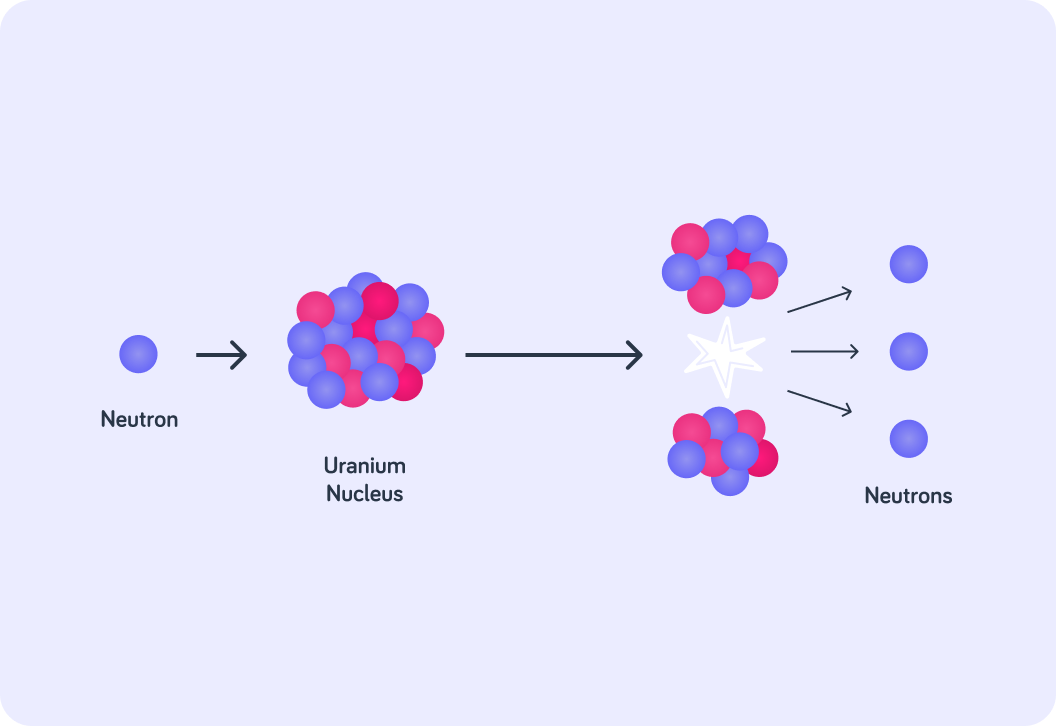YOU ARE LEARNING:
Nuclear Reactions as a Source of Energy

Nuclear Reactions as a Source of Energy
Here we introduce what nuclear fusion and fission reactions are and how they produce energy.
The protons and neutrons in the nucleus of an atom are held together by a very strong force. Force is proportional to energy, so the nucleus of an atom has...

The nucleus of an atom is held together by what is called the nuclear strong force. It means that the nucleus contains a large amount of energy. We can release this energy in a nuclear reaction and harness it. So we can use nuclear reactions as a source of energy.
Nuclear power releases a lot of energy. In fact, it releases up to 10,000 times more energy per kilogram compared to fossil fuels! This means that nuclear power is...

So nuclear power is really efficient. However, in 2017 only 4.1% of the energy used globally came from nuclear power, compared to 77.5% from fossil fuels. Why do you think that is? Pick all the options you think are correct.

You can select multiple answers
So nuclear power has its advantages and disadvantages. One disadvantage is that it produces radioactive waste. But why does it produce radioactive waste? To answer that, we need to think about the processes that release energy from the nuclei of atoms: Nuclear fission and nuclear fusion.
What are nuclear fusion and nuclear fission?
You may have heard about the word fusion in a different context before. For example, the work of an artist could be a "fusion" of several different styles. What do you think is the definition of nuclear fusion?

Nuclear fusion is when two small nuclei are fused together to form a single, larger nucleus.
This process releases energy.
So fusion is the fusing together of two small nuclei. Fission is the opposite process. Nuclear fission is the process where a nucleus is...

Nuclear fission is when a larger nucleus is split into two smaller fragment nuclei.
This process releases energy, in the form of gamma radiation and kinetic energy. More on that later!
Does this image show nuclear fusion or nuclear fission?


The image shows nuclear fusion. Two smaller nuclei collide, and fuse together to form the nucleus of a helium atom.
This process releases lots of energy! And notice that a neutron is also emitted.

We know that the nucleus which is formed is a helium nucleus because it has 2 protons, and helium has atomic number 2. Which element do the two nuclei that fused together belong to?


It is thought that the hydrogen in a glass of water could release the same amount of energy as a tank full of petrol!
So nuclear fusion releases tremendous amounts of heat and energy. We know that it naturally occurs in stars like our Sun, and is the reason they are so bright and hot.

Do we currently have nuclear fusion reactors that provide us with energy? Answer yes or no.


Scientists have been working on fusion reactors for over 50 years.
However, it is extremely difficult to create the conditions required for nuclear fusion to occur, so we haven't in fact built a nuclear fusion reactor yet. More on this in later lessons!

However, we do currently have nuclear power stations that provide us with energy. What nuclear reactions do they make use of?

This diagram shows the process where energy is released through nuclear fission.
A larger nucleus is split into two smaller nuclei.

In nuclear fission, a large nucleus is struck by a _________.


Not every nucleus is fissionable (can undergo fission). The diagram shows the nucleus that is most commonly used for nuclear fission. What element is that?


We usually use different isotopes of uranium in nuclear fission reactors, because we want to use unstable nuclei.
A uranium nucleus becomes unstable if a neutron strikes and is absorbed. When it decays, it releases energy.

Is nuclear fission a renewable energy source? Answer yes or no.


Nuclear fission is not a renewable energy source, because reserves of uranium are low.
Nevertheless, nuclear fission reactors have been used for over 50 years to provide us with electricity.

In nuclear fission, unstable nuclei are created by firing neutrons at a stable nucleus to be absorbed. The unstable nuclei decay and emit gamma radiation, so we can conclude that an unstable nucleus is...

Uranium is the most common radioactive element used for fuel in nuclear fission. The remnants of the split uranium are highly unstable and therefore radioactive. The radioactive waste produced by the fission process is very dangerous to humans, plants, animals and the environment, so it must be disposed of safely.
So the radioactive waste produced by the fission process is terribly dangerous. What do you think nuclear power stations do to safely dispose of their waste products?

We will look at the details of nuclear reactions in more detail in later lessons, as well as the kind of damage nuclear radiation can cause.
